Freely Available British and Irish Public Legal Information
[Home] [Databases] [World Law] [Multidatabase Search] [Help] [Feedback]
Intellectual Property Enterprise Court
You are here: BAILII >> Databases >> Intellectual Property Enterprise Court >> ASR Interiors Ltd v AWS Trading Ltd & Anor [2022] EWHC 372 (IPEC) (24 February 2022)
URL: http://www.bailii.org/ew/cases/EWHC/IPEC/2022/372.html
Cite as: [2022] EWHC 372 (IPEC)
[New search] [Printable PDF version] [Help]
Neutral Citation Number: [2022] EWHC 372 (IPEC)
Case No: IP-2020-000151
IN THE HIGH COURT OF JUSTICE
BUSINESS AND PROPERTY COURTS OF ENGLAND AND WALES
INTELLECTUAL PROPERTY LIST (ChD)
Intellectual property enterprise court
The Rolls Building
7 Rolls Buildings
London, EC4A 1NL
Date: 24th February 2022
Before:
RECORDER DOUGLAS CAMPBELL QC
- - - - - - - - - - - - - - - - - - - - -
Between:
|
|
ASR interiors limited
|
Claimant |
|
|
- and - |
|
|
|
(1) aws trading limited (2) giatalia international limited |
Defendants |
- - - - - - - - - - - - - - - - - - - - -
Mr Michael Smith (instructed by Taylors Legal Services Limited) appeared on behalf of the Claimant
Mr Ashley Roughton (instructed by Malik Legal Solicitors Limited) appeared on behalf of the First Defendant
The Second Defendant did not appear and was not represented
Hearing date: 13 January 2022
- - - - - - - - - - - - - - - - - - -- - -- - -- - - - -
Judgment approved
RECORDER DOUGLAS CAMPBELL QC :
Introduction
- This is an action for infringement of registered designs.
- The First and Second Defendants are unrelated furniture wholesalers. The nature of their alleged infringement is different and they have been separately represented at all times. Just before this trial began, the Second Defendant (represented by its solicitor’s agent, Ms Pantaleon) applied for an adjournment of the trial against it. This was for Covid-related reasons affecting their trial counsel, and Ms Pantaleon explained that the Second Defendant had not been able to find a replacement. This adjournment was not seriously resisted by the Claimant and the First Defendant, and I granted it. Thus this trial only considers the Claimant’s case against the First Defendant.
- The registered designs now relied upon for purposes of infringement against the First Defendant are 6050903 (‘903), 6050906 (‘906), and 6051281 (‘281). There is a counterclaim for validity in respect of each design.
- Originally the Claimant relied upon two additional registered designs, 6078196 (‘196) and 6063663 (‘663), against the First Defendant: see the Particulars of Claim at 6(d)-(e). Following the case management conference held on 2 July 2021 the Claimant noticed it had self-anticipated both of these designs by selling products made to such designs earlier than the 12-month grace period permitted by section 1B(6)(c) RDA. The First Defendant did not serve any evidence relating to the ‘196 design on grounds of costs (see Yates I paragraph [3]). I will say more about ‘663 below.
- The First Defendant’s defence in relation to each of the 3 registered designs was essentially that the product alleged to infringe pre-dated the relevant registration relied upon. Thus, the products complained of either did not infringe the Claimant’s registrations or they invalidated them.
- The Claimant disputed this. In particular the Claimant alleged that the First Defendant had falsified its evidence so as to make it appear that the products which were alleged to be infringements had in fact been made available prior to the relevant registration dates of the Claimant’s designs. These are serious allegations. Given their seriousness the trial took place in person.
- The list of issues was settled at the case management conference held before HHJ Hacon on 2 July 2021 but as I have already explained the case has developed since then. I will restate the issues which now need to be decided in relation to the First Defendant as follows.
- The significance of the dates is that the ‘903 design was registered on 26 December 2018. The 2 limbs of issue 1(b) derive from paragraph 2 of the original Grounds of Invalidity and paragraph 1 of the Amended Grounds of Invalidity respectively. Only the second limb was supported by the First Defendant’s evidence (see Yates 1 at paragraphs 18-19) hence I will focus on that.
- The registration date of the ‘906 design is also 26 December 2018. I cannot identify where the first limb of issue 2(b) comes from although it appears in the list of issues settled at the case management conference: see paragraph 3(4) thereof. The second limb of issue 2(b) comes from paragraph 3 of Amended Grounds of Invalidity. Only the second limb was supported by the First Defendant’s evidence (see Yates I paragraphs 22-24) so again I will focus on that.
- The registration date of the ‘281 design is 7 January 2019. The first limb of issue 3(b) comes from the original Grounds of Invalidity. I cannot identify where the remaining 3 limbs issue 3(b) come from although they all appear in the list of issues settled at the case management conference: see paragraph 5(b) thereof. Only the Express Living disclosure was supported by the First Defendant’s evidence, so I will focus on that: see Yates 1 at paragraphs 26-27.
- I now need to say more about the ‘663 registration, which is for another type of chair. This design was registered on 21 June 2019 and looks like this (both front and rear views are shown):
- Originally the ‘663 registration was in issue for both validity and infringement in the same way as the other designs. See the list of issues as settled at the CMC on 2 July 2021, at the second paragraph 5 (which should be paragraph 6).
- The First Defendant had served a proposed amended defence on 25 June 2021, signed at that time with a statement of truth by its Director, Mr Nigel Yates. That statement contained the usual rubric that “I understand that proceedings for contempt of court may be brought against anyone who makes, or causes to be made, a false statement in a document verified by a statement of truth without an honest belief in its truth”. In this document the First Defendant averred that it had sold products said to invalidate the ‘663 design to Leen Furniture and Carpet Limited (“Leen”) on 10 May 2019. It exhibited a sales order 3959 in support of such sale. This sales order appeared to be for a marble table and 6 Lewis chairs. The Lewis chair was the First Defendant’s product, which was said at that time to infringe the ’663 design.
- The Claimant alleged in its Amended Reply that Leen had placed no such order, that sales order 3959 was fabricated, and that such false allegations demonstrated the First Defendant’s propensity to rely on false evidence in support of its case: see paragraphs 2A-2F thereof. Both sides recognised the importance of this issue and subsequently served evidence directed to it: see Goraya 1 and 2 (for the Claimant) and Dean and Yates (for the Defendant).
- The issue of sales order 3959 also gave rise to two interim hearings which I heard on 5th November 2021 and 21st December 2021.
- The upshot was that although infringement of the ‘663 registration was not an issue for trial given the Claimant’s acceptance that ‘663 was invalid for other reasons, the importance of sales order 3959 to the First Defendant’s credibility (and specifically to Mr Yates’s credibility) meant that it was the single biggest issue of fact at the trial.
- In his opening skeleton argument Mr Roughton, trial Counsel for the First Defendant, raised 2 points of law. The first related to the definition of “designer” in s 1B of the Registered Designs Act 1949 (as amended). The second was whether the registrations relied upon were limited by reference to colour, contrast, and/or texture. Mr Smith, Counsel for the Claimant pointed out that neither of these points had been pleaded by Mr Roughton’s predecessor, and told me that if these had been pleaded then the Claimant would have run its case differently as a result.
- Mr Roughton accepted that his argument on the definition of “designer” was unpleaded and he did not press it. He was right to do so and I am grateful to him. Mr Roughton submitted that I should still take his arguments on colour, contrast and texture (particularly colour) into account on the grounds that construction of the relevant registration is a matter for the Court. I agree with Mr Roughton that construction is a matter for the Court, but this does not answer Mr Smith’s argument that the Claimant would have run its case differently if the Defence and Counterclaim had specifically referred to colour as being a feature of the relevant registrations (to which Mr Roughton had no specific answer). In those circumstances I find that it would not be fair on the Claimant to allow the First Defendant to take such points now, particularly having regard to CPR Parts 63.20(1) and 63.23(2).
- Both counsel were focussed and realistic. This meant that the trial was completed in a day although it covered a lot of ground. I am grateful to them both.
- Mr Salman Rahim, Director of the Claimant, is the person who signed the Claimant’s statements of case. He attended Court and was cross-examined briefly. He agreed he had not contacted Express Living in connection with this case.
- Mr Simarjit Singh Goraya, sole director of Leen, also attended Court and was cross-examined. He was a softly spoken individual and it appeared to me likely that English was his second language. He gave evidence about sales order 3959 which was unshaken in cross-examination. He was asked about his failure to supply certain emails said to be connected to that order but it turned out that this was because the First Defendant had never asked for them to be supplied in the first place. He was a good witness and I accept his evidence.
- The First Defendant had been permitted to serve up to 5 witness statements given the width of its pleading on prior use: see the CMC Order of HHJ Hacon at paragraphs 1(1) and 9. In the event it served witness statements from only 3 people: its Sales Administrator, Jamie Dean; the Operations Manager of Express Living, Dalwinder Singh; and its Director, Nigel Yates.
- Mr Dean’s statement was served on 10th November 2021. It was put forward in order to explain the state of the First Defendant’s records on sales order 3959, which were stored on a Sage system. However Mr Dean did not attend for cross-examination and no reason (whether good or bad) was given as to why not. It appears from his statement that he remains employed by the First Defendant and I was not told this had changed. No Civil Evidence Act notice was formally served, but even if it had been I would have given his statement no weight.
- Mr Singh’s evidence was 5 paragraphs long and was directed toward showing that Express Living had placed an order for items described as 6 “Rose chair/Mink” and 1 “Roma Sideboard” in or around 7th December 2018. He exhibited the delivery note for this item but this note did not show what the products actually looked like.
- Upon the First Defendant’s application, I permitted Mr Singh to give evidence via video link. The first time contact was made with Mr Singh, he appeared to be driving a van while dividing his attention between the road in front of him and the camera of a mobile device placed on the passenger seat. I immediately stopped the hearing. I then directed the First Defendant to re-establish contact once Mr Singh had stopped driving. The second time contact was made, Mr Singh appeared to be in a busy office with distracting amounts of background noise. I asked him if he could find a quieter place, which he did. This appeared to be a store room in the same building. However after being sworn it turned out that he had left his witness statement in the busy office. Hence he left the video link running while he went back to the busy office, then returned to the store room with it. He was then asked about his exhibit to his witness statement, but he did not have that exhibit with him nor did he appear to know where it was. Similarly he did not seem to know about a brochure to which he had referred in his statement. At this point Mr Roughton wisely accepted that the process was not turning out to be a successful one, and indicated that he would simply rely on Mr Singh’s statement for such weight as it might be thought to be worth. This was again realistic. In those circumstances I give Mr Singh’s statement no weight.
- I mention this not in order to determine who, if anyone, was at fault in relation to the way in which this happened. It may have been a combination of things. I do so because giving evidence by video link may be with us for some time to come, and this story illustrates the problems that can arise when things go wrong. Anyone who seeks, and obtains, an order permitting evidence to be given by video link would be well advised to think carefully about how the process of giving evidence will actually happen. At a bare minimum, when the time comes for the video link to be activated the witness should be in a room with all the case papers before him or her and with no distractions. Otherwise the risk is that the evidence which the party seeks to adduce from that witness will not be given properly, or at all, with potentially adverse consequences for that party’s case.
- Mr Yates was cross-examined. He was a belligerent witness. I accept Mr Roughton’s submission that this was not surprising given the seriousness of the allegations made against him. However I regret to say that on certain important issues in the case I did not believe his evidence. This was for more substantial reasons than his demeanour in court. I will explain why in more detail below.
- There was no dispute as to the law. I will take the same approach as I recently did in another registered design case, Erol v Posh Fashion [2022] EWHC 195 (IPEC) and simply set out some key points.
- The requirements of novelty and individual character are set out in s 1B of the Registered Designs Act 1949 (as amended), as follows:
- As regards individual character I bear in mind HHJ Hacon’s analysis thereof in Cantel Medical (UK) Ltd v ARC Medical Design [2018] EWHC 345 (Pat) at [181]-[182].
- The overall impression produced on the informed user is central not only to validity (as above) but to infringement, which is governed by section 7 of the Act as follows:
- The informed user has the characteristics identified by HHJ Birss QC in Samsung Electronics (UK) Ltd v Apple Inc [2012] EWHC 1882, approved by the Court of Appeal in Magmatic Ltd v PMS International Ltd [2014] EWCA Civ 181.
- I will begin with the sales order itself. It refers to 6 items of “Lewis Chair/Light Grey” at a unit price of £85. The face of the document indicates that they were ordered by Leen on 10th May 2019.
- Mr Goraya was “100% sure” that Leen did not place sales order 3959. He agreed that he might have seen this or a similar product online in May-June 2019 but no specific online material was put to him or shown to me. Mr Goraya was firm that he did not see a physical sample of it until September 2019. He saw the product again at a show in January 2020. He did not order a Lewis chair from the First Defendant until 17 February 2020. He exhibited a sales order showing that first purchase. He also exhibited 2 other sales orders which were placed by Leen with the First Defendant in May 2019 but which were for different products. It was not put to him that he was lying about any of this, far less than he had any reason to do so.
- Mr Yates said that this sales order might not have been followed up by Leen but I do not believe it was actually put to Mr Goraya himself that this is what happened. Instead the questioning focussed on whether it was right to call Leen a customer of the First Defendant if Leen only placed an order but did not follow it up. I did not understand why this explained why there were no electronic copies of this sales order. This is particularly so when the First Defendant was able to and did produce a purported hard copy of sales order 3959 from somewhere.
- Mr Yates said in cross-examination that the reason why the First Defendant never produced the electronic copy (including metadata) of sales order 3959 was because the First Defendant had changed its computer a number of times. This was a new reason given for the first time in cross examination and I did not believe it. If it had been true then either Mr Dean or Mr Yates himself would have said so in their written statements dealing with sales order 3939.
- Nor was any explanation given as to why changing computers would have meant the loss of recent business records. Mr Dean might have been able to explain this, but he was not called and no reason was given as to why he was not called.
- Next I note that the First Defendant’s price list for 2019 (see A383-384) does not contain any reference to Lewis chairs, or indeed to any of the alleged prior uses of any of the other designs in issue. There is a reference to Lewis Chairs with Chrome in a 2019/2020 price list, albeit priced at £89. These documents are consistent with Mr Goraya’s evidence that he did not buy Lewis Chairs from the First Defendant until February 2020.
- The absence of Lewis Chairs from the 2019 price list is difficult to understand if the products had actually been on sale to customers at that time. The price list is used to tell customers about products and the First Defendant would have had no reason to keep its products secret.
- In paragraph 10 of his witness statement Mr Yates referred to Mr Goraya’s statement and to the Claimant’s reliance on the 2019 price list. Mr Yates said “There would be occasions when a new product just misses one brochure and will have been offered for six months before it features in a brochure. There have been occasions when unfortunately owing to an error a product has not been included in a brochure”. It will be seen that he did not say either of these general statements applied to the Lewis Chair in particular, even though he was addressing the Claimant’s case about the Lewis Chair in that part of his written evidence.
- In his oral evidence he said for the first time that both of these general statements did apply to the Lewis Chair after all. There was no documentary support for this, nor was he able to give any examples when this type of situation had ever happened apart from the Lewis Chair. I did not believe him. If it had been true he would have said so in the first place.
- I also note that the price list is actually a simple two page typewritten list which could easily have been updated. It is not a “brochure” as such. The first brochure in which the Lewis Chair appeared is the document entitled “New Chair brochure” (capitals in the original) which an employee of the First Defendant called Chaniece circulated to a customer called Shawn Furniture on 7 October 2020. Mr Yates was asked about this and sought to disparage Chaniece on the grounds she was merely a temporary employee. Chaniece was not called by the First Defendant either, so it was not possible to explore why she called this brochure the “NEW Chair brochure”.
- Mr Yates relied on some additional documents relating to the Lewis chair. One was a sales order to Modern Furniture and Lighting dated 14th November 2018, but although this referred to something which was called a Lewis Chair that did not show what the product looked like. Nor did other documents he exhibited, including an invoice to Anji dated 11th September 2018 and a Bower Green customs clearance document dated 31st October 2018. He did exhibit some Chinese design documents dated 16th July 2017 but the accuracy of that claimed date was not established. These documents did not take matters further.
- Finally, in response to Mr Goraya’s evidence, Mr Yates had alleged that Leen placed another sales order, number 7825 (see Yates 30). Mr Goraya said in his second witness statement that Leen never placed this sales order either. This part of Mr Goraya’s evidence was not challenged at all, as the Claimant pointed out in closing, and I accept Mr Goraya’s evidence on this point. It follows (as the Claimant submitted) that sales order 7825 must have been fabricated as well, since no other possibility was identified.
- Falsification is a serious allegation and needs to be proved by cogent evidence. The evidence before me is sufficiently cogent for me to conclude that sales order 3959 to Leen has been fabricated, and I so find. So for that matter was sales order 7825. Neither party suggested that anyone other than Mr Yates himself could have performed such a fabrication, and I find that he did.
- This does not mean that I automatically disbelieve all of Mr Yates’s evidence on other issues, but in my view it is unsafe to rely on anything Mr Yates said which is unsupported by other material.
- The first question is whether D1’s sideboard product produces a different overall impression to the ‘903 design. I refer to the reproductions of each set out above.
- No particular points were pleaded in the Defence: see paragraph 6 thereof. Mr Yates said in his written evidence that there were 4 differences (see his paragraph 17):
- Point (i) is irrelevant since the ‘903 design is not restricted to any given overall size. I will assume that both of points (ii) and (iii) are correct, although this is not clear from the only depictions in the evidence. Point (iv) is simply wrong and I do not understand why Mr Yates said it, but to be fair he accepted that this was a mistake.
- A quite different set of points was taken in the First Defendant’s skeleton argument.
- I do not agree that the ‘903 registration shows an “inner void”. The informed user would in my view interpret that part of the design as showing that side of the sideboard in shade. This means that point (1) is not a difference.
- I do agree that there are some differences between the First Defendant’s product and the ‘903 registration, as per Mr Yates’s (ii) and (iii) and points (2) and (3) from the skeleton argument. However I find that the overall impression produced on the informed user is still the same. See for instance the arrangement of doors at each end; the 3 drawers in the middle; and the appearance of each such feature, having a distinct border around the perimeter and a crushed diamond finish within such border.
- The next question is whether the First Defendant’s sideboard product was made available to the public in by selling it to Express Living on or about 7 December 2018.
- The First Defendant’s documentation shows as follows:
- This documentation is confusing and unsupported by any first hand evidence apart from that of Mr Yates. For instance there was nothing from Sun Xubo. At most I could conclude that 10 sideboards of some description were imported, but even this is inconsistent with the customs clearance and delivery invoice.
- Nor is it clear why the design documents have been produced by one Chinese company in one province and the manufacturing done by another Chinese company in another province if both sets of documents relate to the same product. Mr Yates was asked about this but was unable to provide any convincing explanation.
- I have already explained I give no weight to Mr Singh’s evidence.
- I have also already said that the alleged disclosure at the Manchester furniture show (relied upon in the First Defendant’s original Grounds of Invalidity, supported by a statement of truth) was not pursued. In any event it was not clear how goods which only arrived on 26th November 2018 could have been exhibited at a show held in July 2018.
- On the basis of this evidence, I find that the First Defendant’s sideboard product was not made available to the public before the priority date of ‘903.
- The first question is whether D1’s Roma wing product produces a different overall impression to the ‘906 design. I refer to the reproductions of each set out above.
- Mr Yates said there were two differences, one being “our wings are a larger size” and the other being “the crystals with our wings are larger dimensions”. I do not accept the first point since the ‘906 design is not restricted to any given size. I do not accept that the second point is a difference at all, let alone one which is such as to create a different overall impression.
- I consider that the overall impression is the same in both cases. This is supported by the statement in the First Defendant’s skeleton argument that “It is hard to claim that these two articles are not anything but very close if not identical.” This position was realistic whereas Mr Yates’s position was not.
- The second question is whether the First Defendant’s said Roma wing product was made available to the public by the First Defendant by selling it to Discount World in or about 19 July 2018.
- The position on the documentation is similar to the ‘903 design: ie, confused and unsupported by any first hand evidence apart from that of Mr Yates.
- Once again Mr Yates was unable to provide any convincing explanation as to why the design had been done by one company in one Chinese province and the manufacture done by a different company in another.
- Taking the above evidence into account I find that the First Defendant’s Roma wing product was not made available to the public before the priority date of ‘906.
- The first question is whether D1’s Rose Chair design produces a different overall impression to the ‘281 design.
- No particular points were pleaded in the Defence: see paragraph 6 thereof. Mr Yates said there were differences in the size of the chairs, the fabric, the nap of the fabric, the colours, and the presence of 4 row buttons on the back while the ‘281 design had three rows. He said this last difference alone “results in a completely different appearance to the back of the chair”. I reject this evidence. The overall impression is the same.
- Again a different set of arguments were made in the First Defendant’s skeleton argument. For instance it was suggested that there might be differences in areas which are not visible from the rear. I reject this. First, if there were any such differences the First Defendant should have pleaded them and then proved them in evidence. Secondly, Mr Yates’s evidence did not claim there were any such differences.
- The next question is whether D1’s Rose Chair was made available to the public by the First Defendant by selling it to Express Living on 7 December 2018.
- The starting point here is Mr Yates’s evidence that he personally suggested the design of this product. Specifically, Mr Yates says he started with a product called the Cheshire Chair, which was the same as the Rose Chair but without the lion head knocker on the back. Mr Yates said he requested Anji Yuetan Household Co Ltd, Zhejiang Province, China (“Anji”) in early 2018 to manufacture and sell to the First Defendant chairs like the Cheshire Chair but with the lion head knocker.
- In support of this, Mr Yates exhibited an email from Anji dated 10th March 2021 which stated in part as follows:
- The author of this email did not give evidence, hence I only have the text of the email itself. This text is inconsistent with Mr Yates’s evidence. If Mr Yates’s evidence were true, it would not say that the chair was developed “by our team”, it would say that it was developed or at least suggested by Mr Yates. The tone of the email also suggests that this was the first contact between the First Defendant and Anji, since otherwise it is difficult to see why Anji would thank the First Defendant for its interest and provide the information given.
- The email attached a picture of a chair. The file name of this photograph began with the numbers “20210310”. If this indicated that the creation date of the file was 10th March 2021, that would be consistent with the date of the email but I do not rely on this.
- Along with this there were various design documents relating to the Rose Chair. These bore the company name of Zhejiang Rongxin Home Textiles Technology Co Ltd and named the designer as Li. Li did not give evidence.
- These documents had a date of 16th July 2017. An odd feature of these drawings is that the lion’s head is much clearer than the depiction of the rest of the chair. The Claimant submitted, and I agree, that it looked like the lion’s head had been added to the drawing later.
- Mr Yates exhibited some additional documentation, as follows:
- This documentation is again unclear and involves multiple apparently unrelated companies. Again it is unsupported by any first hand evidence apart from that of Mr Yates. Indeed, the email from Anji undermines the First Defendant’s case.
- Taking the above evidence into account I find that the First Defendant’s Rose Chair was not made available to the public before the priority date of the ‘281 registration.
- In conclusion I find that:
The issues
1. In relation to the ‘903 design:
a. Does D1’s “Sideboard” product, shown below right, produce a different overall impression to the ‘903 design, shown below left?
b. Was D1’s Sideboard product made available to the public by the First Defendant by (i) exhibiting it and offering it for sale at the Manchester Furniture Show held in July 2018 (ii) selling it to Express Living & Beds Ltd (“Express Living”) on or about 7 December 2018?
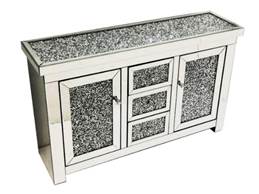
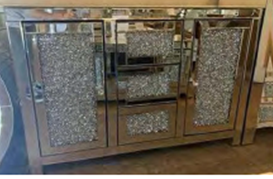
2. In relation to the ‘906 design:
a. Does D1’s “Roma wing” product, shown below right, produce a different overall impression to the ‘906 design, shown below left?
b. Was D1’s said Roma wing product made available to the public by the First Defendant by selling it to (i) Britannia Mirrors Ltd on or about 3 July 2018, or to (ii) Discount World in or about 19 July 2018?
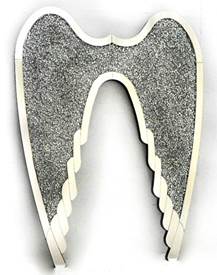
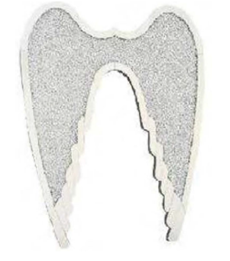
3. In relation to the ‘281 design:
a. Does D1’s “Rose Chair” product, shown below right, produce a different overall impression to the ‘281 design, shown below left?
b. Was D1’s said Rose Chair made available to the public by the First Defendant by (i) exhibiting it and offering it for sale at the Manchester Furniture Show held in July 2018 (ii) selling it to Modern Furniture and Lighting on 14 November 2018 (iii) selling it to Fennell Ltd on 26 November 2018 (iv) selling it to Express Living on 7 December 2018?
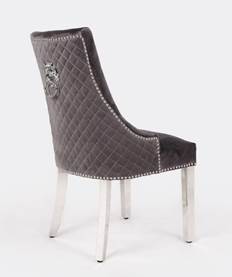
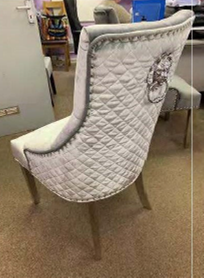
The ’663 registration and sales order 3959
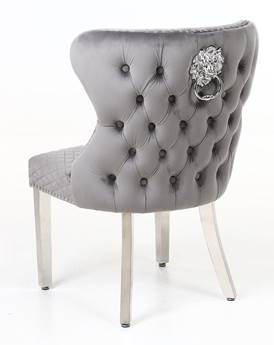
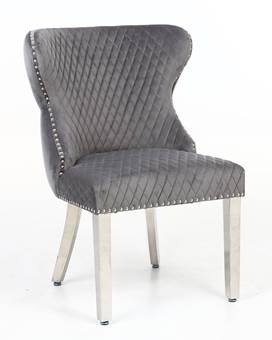
1) In the first hearing, upon the Claimant’s application, I ordered the First Defendant to disclose “electronic copies, in their original format and copied in such a way that each document’s metadata is preserved, [of sales order 3959] plus any emails attaching that document”: see my order of that date at paragraph [3].
2) The First Defendant did not provide any such disclosure pursuant to that order. This prompted the Claimant’s second application, where the Claimant applied to strike out the First Defendant’s defence for failure to provide such disclosure. The First Defendant resisted that application to strike out on the grounds that it did not have any such documents to disclose. It submitted (via its then Counsel, Mr Cook) that any failure to disclose was a matter going to credibility at trial, not a matter for strike out at an interim stage. I accepted the First Defendant’s submissions and dismissed the Claimant’s strike out application on that basis.
Issues which did not arise
The witnesses and their evidence
Legal context
1B Requirement of novelty and individual character.
(1)A design shall be protected by a right in a registered design to the extent that the design is new and has individual character.
(2)For the purposes of subsection (1) above, a design is new if no identical design or no design whose features differ only in immaterial details has been made available to the public before the relevant date.
(3)For the purposes of subsection (1) above, a design has individual character if the overall impression it produces on the informed user differs from the overall impression produced on such a user by any design which has been made available to the public before the relevant date.
(4)In determining the extent to which a design has individual character, the degree of freedom of the author in creating the design shall be taken into consideration…
7 Right given by registration.
(1)The registration of a design under this Act gives the registered proprietor the exclusive right to use the design and any design which does not produce on the informed user a different overall impression…
Sales order 3959 - analysis
The 903 design
(i) The overall sizes are different.
(ii) The mitre corners on the doors and drawers are different.
(iii) The First Defendant’s product has a plain mirrored diamond top while the ‘903 design has a crushed diamond top
(iv) The doors on the front of the First Defendant’s sideboard do not have handles.
(1) The main one is that the left hand side panel in ‘903 was said to show an inner void, not present in the First Defendant’s product.
(2) It was now accepted that there are handles (or knobs) on the doors, but it was submitted that they were in a different place.
(3) There were other points of detail, such as the amount of left or right overhang on the top board.
a) There are two documents in Chinese, both dated 10th April 2018 and both marked as having been produced by Sun Xubo. Mr Yates said these were design documents produced by a company called Jinhua Hongke Glass Products Ltd of Zhejiang Province, China.
b) 10 items of something called “Roma Sideboard” was purchased by the First Defendant from Anhui Light Industries International Co (“Anhui”), Hefei, Anhui, China on 13th September 2018: see A240.
c) There is a payment instruction by the First Defendant dated 15th October 2018 in the sum of $10 220, and a commercial invoice for that sum from Anhui dated 21st October 2018. The invoice refers to 10 items of “Roma Sideboard” among a total of 236 items.
d) There is a customs clearance and delivery invoice from Bower Green Limited, of Bradford, dated 30th November 2018 and referring to an arrival date of 26th November 2018. However under “Number and kind of packages, description of Goods”, it says “Jewellery Cheval Mirror, 236 ctns”. The figure of 236 is consistent with the commercial invoice, but the invoice said nothing about any kind of jewellery or invoices.
The ‘906 design
1) There is a sales order showing a sale of something called Roma Wings to Discount World on 19th July 2018, but nothing showing what this product looked like. Discount World are no longer trading.
2) There is a document in Chinese, said to be a design document and dated June 18th, 2021. The design is mainly illegible, save for some sort of vertical feature dividing the two halves of the wing. This feature is not present in the Defendant’s Roma Wings product. The alleged author is not named. This document is said to be produced by a company called Jinhua Jianye Arts & Crafts of Zhejiang Province (ie the same province as Jinhua Hongke Glass Products Ltd).
3) There is a purchase order for something called Roma Wings from Anhui dated 29th May 2018, a payment order dated 25th July 2018, and a further customs clearance form dated 13th July 2018 from Bower Green (and an arrival date of 7th July 2018). The description on the Bower Green form says “559 ctns jewelry cheval mirror” but once again the purchase order form does not use any of the words “Jewelry”, “Cheval”, or “Mirror”.
The ‘281 design
“Thank you for your interest with our chairs, most of our upholstering chairs are exported to UK market.
For the attached photos, the chair with Quilted back & lion head was developed in 2017 by our team and ship to UK from early 2018. We shipped container GYBT-12 to UK Company GROSVENOR BEDS Ltd, regular orders till now fair scene”.
1) A purchase order to yet another Chinese company in yet another Chinese province. This was to Foshan I-Senyi Hardware Co Ltd, Guangdong Province (“Foshan”) dated 21st September 2018. It included reference to two versions of something called a Rose Chair, but did not show what either looked like.
2) An invoice from Foshan dated 31 October 2018. This has 2 illegible pictures of “chair604” and “chair607”, neither showing a rear view.
3) A further customs clearance form from Bower Green showing an arrival date of 28th November 2018 for items described as “Table and Chair 798 Pkgs” from Foshan.
Conclusion
a) Each of the ‘903, ‘906, and ‘281 designs has been infringed by the First Defendant.
b) The First Defendant’s counterclaim for invalidity fails against each of the 903, ‘906, and ‘281 designs.
